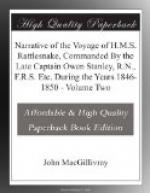LUIZ VAEZ DE TORRES.
The first navigator who saw the shores in question, appears to have been Luiz Vaez de Torres, in the Spanish frigate La Almiranta, coming from the eastward, in August 1606. In latitude 11 1/2 degrees South, Torres came upon what he calls the beginning of New Guinea, which, however, appears to have been a portion of what is now known as the Louisiade Archipelago. Being unable to weather the easternmost point of this land (Cape Deliverance) he bore away to the westward along its southern shores. “All this land of New Guinea,” says he, in his long-forgotten letter to the king of Spain (a copy of which was found in the Archives at Manila, after the capture of that city by the British, in 1762) “is peopled with Indians, not very white, much painted, and naked, except a cloth made of the bark of trees. They fight with darts, targets, and some stone clubs, which are made fine with plumage. Along the coast are many islands and habitations. All the coast has many ports, very large, with very large rivers, and many plains. Without these islands there runs a reef of shoals, and between them (the shoals) and the mainland are the islands. There is a channel within. In these parts I took possession for your Majesty.
“We went along 300 leagues of coast, as I have mentioned, and diminished the latitude 2 1/2 degrees, which brought us into 9 degrees. From hence we fell in with a bank of from three to nine fathoms, which extends along the coast above 180 leagues. We went over it along the coast to 7 1/2 South latitude, and the end of it is in 5 degrees. We could not go further on for the many shoals and great currents, so we were obliged to sail out South-West in that depth to 11 degrees South latitude.”
By this time Torres had reached the Strait which now bears his name, and which he was the first to pass through. He continues: “We caught in all this land twenty persons of different nations, that with them we might be able to give a better account to your Majesty. They give much notice of other people, although as yet they do not make themselves well understood."*
(Footnote. Burney’s Chronological History of Voyages and Discoveries in the South Sea or Pacific Ocean Volume 2 Appendix page 475.)
M. DE BOUGAINVILLE.
M. de Bougainville, in June 1768, with two vessels, La Boudeuse and L’Etoile, was proceeding to the eastward towards the coast of Australia, when the unexpected discovery of some detached reefs (Bougainville’s reefs of the charts) induced him to alter course and stand to the northward. No land was seen for three days. “On the 10th, at daybreak,” says he, “the land was discovered, bearing from east to North-West. Long before dawn a delicious odour informed us of the vicinity of this land, which formed a great gulf open to the south-east. I have seldom seen a country which presented so beautiful a prospect; a low land, divided into plains and groves,




